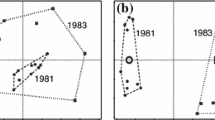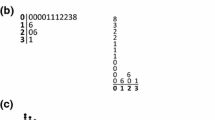Summary
The paper reviews the constraints and influences which have affected the development of numerical classification and ordination of vegetation.
Initial development of ordination techniques and their reception by ecologists was hindered by the mistaken idea that ordination involved acceptance of variation in vegetation as a continuum, as well as by a general suspicion of mathematical approaches.
Three distinct approaches to ordination, largely unrecognised at the time, are apparent in earlier work: direct gradient analysis, reduction in dimensionality and path-seeking (catenation) (Dale 1975).
Modifications of simple initial techniques made them more efficient at the cost of increased computation. Acceptance of heavier computation as computers increased in capacity and speed turned attention to prineipal component analysis and the superficially similar factor analysis. These have been widely misunderstood largely because they were initially applied in the same way as in the analysis of psychological data, in which different constraints and objectives apply. The initial failure to recognise that principal component analysis involves a preliminary data transformation, the form of which depends on answers to biological, not mathematical, questions, was particularly unfortunate.
Principal component analysis has limitations as a technique of ordination resulting from its assumptions of linearity and additivity of plant responses. Attempts to devise more effective techniques raise questions about the practical importance of non-linearity if the objective is data-exploration rather than elucidating the nature of species-response curves and about the adequacy of using simulated data as test data when we do not know how to simulate realistic data.
Data-exploration has been more prominent in practical uses of ordination but many methodological developments have concentrated rather on species-response curves.
Numerical classification also met obstacles to its acceptance additional to a general aversion to numerical techniques. The first numerical techniques were presented in the context of the relationships of a particular set of data, rather than of a generally valid system, which was the more familiar concept in non-numerical classification.
Both numerical and non-numerical classification aim to produce as homogeneous groups as possible. The distinctive contribution of numerical methods is to allow the data to indicate the most efficient criteria of classification; this was an unfamiliar idea.
The strategy of classification may be either divisive or agglomerative and either monothetic or polythetic. Choice of strategy in earlier work was not only constrained by computational limitation but may also have been influenced by an author's previous experience of non-numerical classification. As with ordination, the distinction between preliminary data transformation and subsequent analysis was at first not appreciated.
Numerical classification has been influenced by parallel numerical developments in formal taxonomy. Because objectives and assumptions are not always the same, this influence has not been altogether helpful.
The limitations of real data suggest that developments of technique are at risk of becoming too concerned with refinements of methodology. Increasingly complex methods and increasing availability of programmes for such methods carry the risk that they may be used without adequate understanding of what they do.
Similar content being viewed by others
References
Ashby, E. 1936. Statistical ecology. Bot. Rev. 2: 221–35.
Ashby, E. 1948. Statistical ecology. II. A reassessment. Bot. Rev. 14: 222–34.
Ashton, P.S. 1964. Ecological studies in the mixed dipterocarp forest of Brunei State. Oxf. For. Mem. 25.
Austin, M.P. 1976. On non-linear species response models i ordination. Vegetatio 33: 33–41.
Austin, M.P. & P., Greig-Smith. 1968. The application of quantitative methods to vegetation survey. II. Some methodological problems of data from rain forest. J. Ecol. 56: 827–44.
Austin, M.P. & L., Orloci. 1966. Geometric models in ecology. II. An evaluation of some ordination techniques. J. Ecol. 54: 217–27.
Bray, J.R. & J.T., Curtis. 1957. An ordination of the upland forest communities of southern Wisconsin. Ecol. Monogr. 27: 325–49.
Blackith, R.E. & R.A., Reyment. 1971. Multivariate Morphometrics. Academic Press, London and New York.
Cormack, R.M. 1971. A review of classification. Jl R. statist. Soc. A. 134: 321–67.
Curtis, J.T. 1959. The Vegetation of Wisconsin. Univ. of Wisconsin Press, Madison.
Curtis, J.T. & R.P., McIntosh. 1951. An upland forest continuum in the prairie-forest border region of Wisconsin. Ecology 32: 476–96.
Dale, M.B. 1975. On objectives of methods of ordination. Vegetatio 30: 15–32.
Dagnelie, P. 1960. Contribution à l'étude des communautés végétales par l'analyse factorielle. Bull. Serv. Carte phytogéogr. Sér. B 5: 7–71, 93–105.
Edwards, A.W.F. & L.L., Cavalli-Sforza. 1965. A method for cluster analysis. Biometrics 21: 39–63.
Ellenberg, H. 1953. Physiologisches und ökologisches Verhalten derselben Pflanzenarten. Ber. dt. bot. Ges. 65: 350–61.
Fisher, R.A. 1925. Statistical Methods for Research Workers. Oliver and Boyd, Edinburgh.
Gauch, H.G., G.B., Chase. & R.H., Whittaker. 1974. Ordination of vegetation samples by Gaussian species diatribution. Ecology 55: 1382–90.
Goodall, D.W. 1953. Objective methods for the classification of vegetation. I. The use of positive interspecific correlation. Aust. J. Bot. 1: 39–63.
Goodall, D.W. 1954. Objective methods for the classification of vegetation. III. An essay in the use of factor analysis. Aust. J. Bot. 2: 304–24.
Goodall, D.W. 1970. Statistical plant ecology. Ann. Rev. Ecol. Syst. 1: 99–124.
Gower, J.C. 1966. Some distance properties of latent root and vector methods used in multivariate analysis. Biometrika 53: 325–38.
Gower, J.C. 1967. Multivariate analysis and multidimensional geometry. Statistician 17: 13–28.
Greig-Smith, P. 1957. Quantitative Plant Ecology. Butterworth, London.
Greig-Smith, P. 1964. Quantitative Plant Ecology, 2nd edn. Butterworth, London.
Greig-Smith, B. 1980. Quantitative Plant Ecology, 3rd edn. In preparation.
Greig-Smith, P., M.P., Austin & T.C., Whitmore. 1967. The application of quantitative methods to vegetation survey. I. Association-analysis and principal component ordination of rain forest. J. Ecol. 55: 483–503.
Hall, John B. & D.U.U., Okali. 1978. Observer-bias in a floristic survey of complex tropical vegetation. J. Ecol. 66: 241–9.
Hall, J.B. & M.D., Swaine. 1976. Classification and ecology of closed-canopy forest in Ghana. J. Ecol. 64: 913–51.
Hill, M.O. 1973. Reciprocal averaging: an eigenvector method of ordination. J. Ecol. 61: 237–49.
Hill, M.O., R.G.H., Bunce & M.W., Shaw. 1975. Indicator species analysis, a divisive polythetic method of classification, and its application to a survey of native pinewoods in Scotland. J. Ecol. 63: 597–613.
Ihm, P. & H.van, Groenewoud. 1975. A multivariate ordering of vegetation data based on Gaussian type gradient response curves. J. Ecol. 63: 767–77.
Lambert, J.M. 1972. Theoretical models for large-scale vegetation survey. Mathematical Models in Ecology (ed. by J.N.R., Jeffers), pp. 87–109. Blackwell, Oxford.
Lambert, J.M., S.E., Meacock, J., Barrs & P.F.M., Smartt. 1973. AXOR and MONIT: two new polythetic-divisive strategies for hierarchical classification. Taxon 22: 173–6.
Macnaughton-Smith, P., W.T., Williams M.B., Dale. & L.G., Mockett. 1964. Dissimilarity analysis: a new technique of hierarchical subdivision. Nature, Lond. 202: 1034–5.
Noy-Meir, I. 1973a. Data transformations in ecological ordinations. I. Some advantages of non-centering. J. Ecol. 61: 329–41.
Noy-Meir, I. 1973b. Divisive polythetic classification of vegetation data by optimized division on ordination components. J. Ecol. 61: 753–60.
Noy-Meir, I. 1974. Catenation: quantitative methods for the definition of coenoclines. Vegetatio 29: 89–99.
Noy-Meir, I. & M.P., Austin. 1970. Principal component ordination and simulated vegetational data. Ecology 51: 551–2.
Noy-Meir, I., D., Walker & W.T., Williams. 1975. Data transfortions in ecological ordination. II. On the meaning of data standardization. J. Ecol. 63: 779–800.
Orlóci, L. 1966. Geometric models in ecology, I. The theory and application of some ordination methods. J. Ecol. 54: 193–215.
Orlóci, L. 1967. Data centering: a review and evaluation with reference to component analysis. Syst. Zool. 16: 208–12.
Orlóci, L. 1974. Revisions for the Bray & Curtis ordination. Can. J. Bot. 52: 1773–6.
Orlóci, L. 1975. Multivariate Analysis in Vegetation Research. W. Junk, The Hague.
Orlóci, L. 1978. Multivariate Analysis in Vegetation Research, 2nd edn. W. Junk, The Hague.
Pearson, K. 1901. On lines and planes of ciosest fit to systems of points in space. Phil. Mag. 6: 559–72.
Sibson, R. 1971. Some observations on a paper by Lance & Williams. Comput. J. 14: 156–7.
Sobolev, L.N. & V.D., Utekhin. 1973. Russian (Ramensky) approaches to community systematization. Ordination and Classification of Communities (Handbook of Vegetation Science Vol. 5), p 75–103. W. Junk, The Hague.
Sørensen, T. 1948. A method of establishing groups of equal amplitude in plant sociology based on similarity of species content. Biol. Skr. 5(4): 1–35.
Swan, J.M.A. 1970. An examination of some ordination problems by use of simulated vegetation data. Ecology 51: 89–102.
Swan, J.M.A., R.L., Dix & C.F., Wehrhahn. 1969. An ordination technique based on the best possible stand-defined axes and its application to vegetational analysis. Ecology 50: 206–12.
Tansley, A.G. 1923. Practical Plant Ecology. George Allen and Unwin, London.
Whittaker, R.H. 1952. A study of summer foliage insect communities in the Great Smoky Mountains. Ecol. Monogr. 22: 1–44.
Whittaker, R.H. 1956. Vegetation of the Great Smoky Mountains. Ecol. Monogr. 26: 1–80.
Whittaker, R.H. 1960. Vegetation of the Siskiyou Mountains, Oregon and California. Ecol. Monogr. 30: 279–338.
Whittaker, R.H. 1967. Gradient analysis of vegetation. Biol. Rev. 42: 207–64.
Whittaker, R.H. (ed.) 1973. Ordination and Classification of Communities (Handbook of Vegetation Science, Vol. 5). W. Junk, The Hague.
Williams, W.T. (ed.), 1976. Pattern Analysis in Agricultural Science. CSIRO and Elsevier, Melbourne and Amsterdam.
Williams, W.T. & J.M., Lambert. 1959. Multivariate methods in plant ecology. I. Association-analysis in plant communities. J. Ecol. 47: 83–101.
Williams, W.T. & J.M., Lambert, 1960. Multivariate methods in plant ecology. II. The use of an electronic digital computer for association-analysis. J. Ecol. 48: 689–710.
Williams, W.T., G.N., Lance, M.B., Dale. & H.T., Clifford. 1971. Controversy concerning the criteria for taxonometric strategies. Comput. J. 14: 162–5.
Author information
Authors and Affiliations
Rights and permissions
About this article
Cite this article
Greig-Smith, P. The development of numerical classification and ordination. Vegetatio 42, 1–9 (1980). https://doi.org/10.1007/BF00048864
Received:
Issue Date:
DOI: https://doi.org/10.1007/BF00048864




